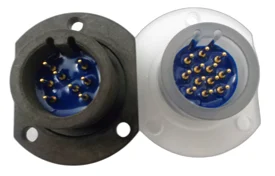Design for Manufacturability, or DFM, is the practice of designing products in a way that makes them easy and cost-effective to manufacture. This is especially important in the field of hermetic electrical feedthroughs. Hermetic electrical feedthroughs provide a sealed electrical connection between the inside and outside of a sealed enclosure. They are airtight and withstand extreme environments, making them essential for many applications where electrical components need protection from the elements or contaminants. Douglas’ hermetic solutions offer more design flexibility than traditional hermetic connectors.
Customers can start to consider the complete design for manufacturability to reduce labor and increase quality. Epoxy-based feedthroughs offer design flexibility to make improvements.
Design Considerations
One of the key considerations in the design of hermetic electrical feedthroughs is efficient and consistent manufacturability. This requires taking into account the materials and processes used in their production, as well as any potential issues that may arise during manufacturing. Douglas Electrical Components partners with engineers of various disciplines to ensure the right fit, form, and function for the application. This includes creating hermetic solutions that are plug-and-play in the manufacturing environment. Our team can hermetically seal virtually any type of connector, wire or optical fiber, increasing flexibility to create a customized solution that saves time and reduces the number of components while maintaining or increasing quality.
We partner with various customers to integrate housings, connectors, wires, cable jackets, labeling, and more, to simplify the integration process and manufacturability.
Available Materials
.png?width=275&height=176&name=molded%20connector%20potting%20(1).png)
One important aspect of DFM for hermetic electrical feedthroughs is the selection of materials. The materials used must be able to withstand the extreme environments that the feedthroughs will be subjected to, as well as being compatible with the manufacturing processes used to produce them. Using epoxy technology, our hermetic electrical feedthroughs are able to create high-density electrical connections using a variety of housing materials including metals and plastics. This differs from other technologies such as glass-to-metal sealing that are challenged by the manufacturing process temperature.
Electrical connection flexibility is also important; Douglas can hermetically seal to a variety of electrical connections including pins, solder cups, wires, flex circuits and optical fibers. Additionally, our technology permits sealing directly to jacketed cables for added protection and strain relief.
Some examples of hermetic feedthroughs designed for OEM applications are shown below.
Fitting the Current Layout
.png?width=300&height=238&name=backpotting%20flange%20wire%20-%20rear%20view%20(1).png)
Another aspect of DFM for hermetic electrical feedthroughs is the design of the feedthrough itself. The design should take into account the materials and processes used in its production, as well as any potential issues that may arise during manufacturing. For example, the design should minimize the number of complex features or tight tolerances, as these can be difficult and expensive to produce. Douglas can hermetically seal within existing housings with complex geometries and layouts with power solutions exceeding 30,000V. We solve new applications challenges each day featuring unique geometries, so customers can install and service their design properly.
Douglas Electrical can also remove some of the complexity of the existing design by integrating a fully connectorized wire or cable harness. Our IPC-620 certified technicians manufacture full cable harnesses for turnkey installations.
Looking to start your next design or review an existing one? Reach out to our team below.


